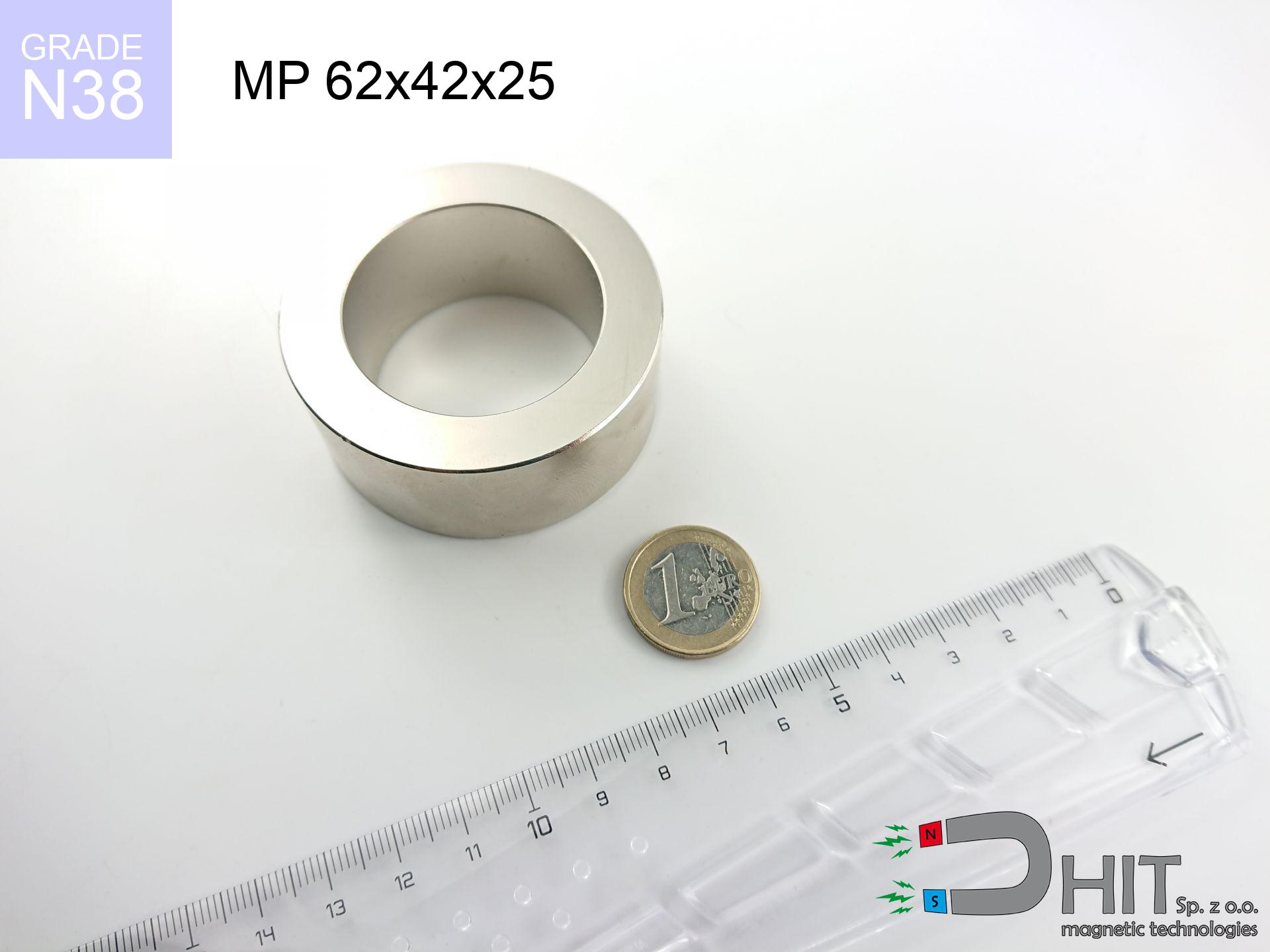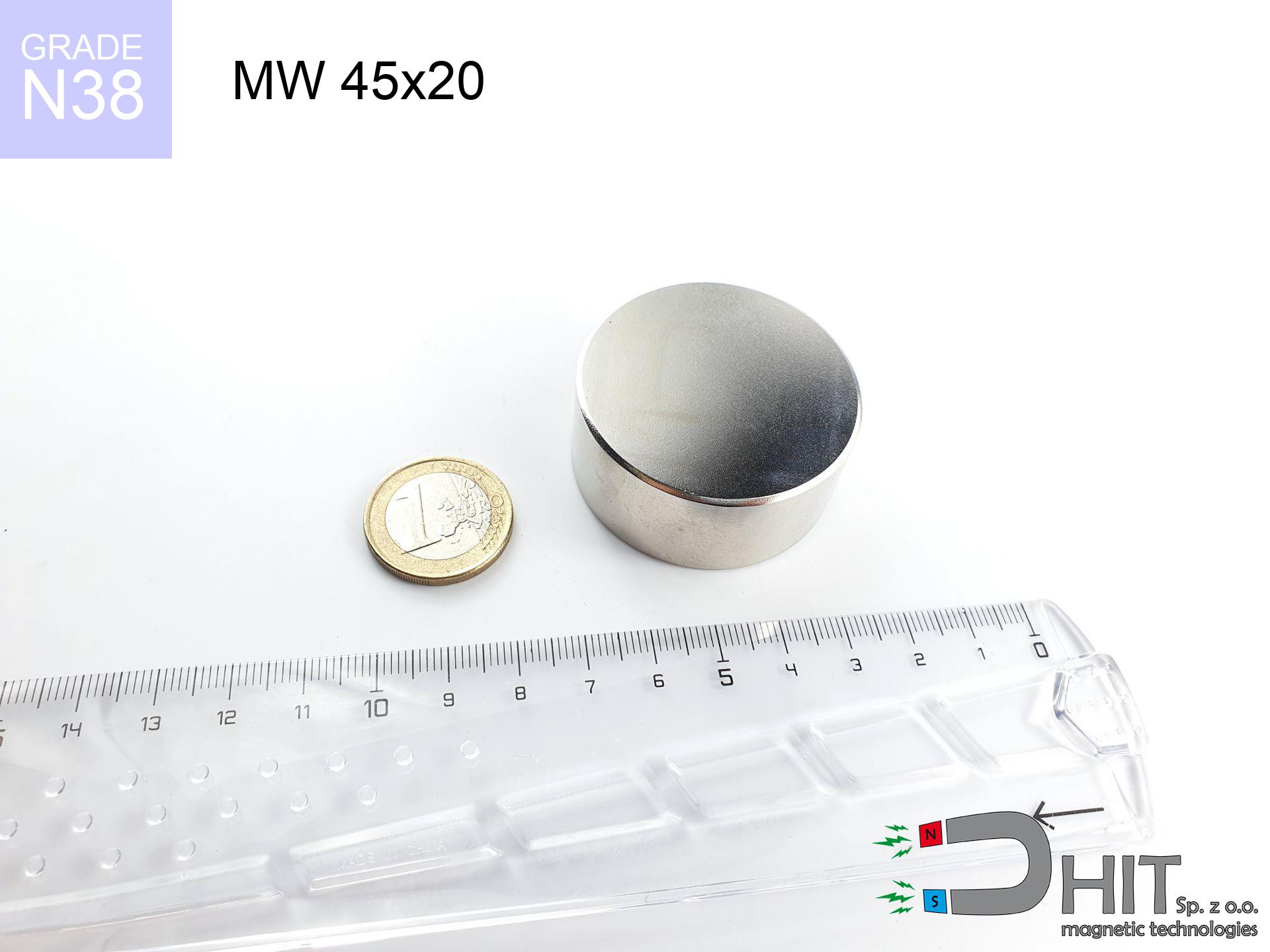UMGW 36x18x8 [M8] GW / N38 - magnetic holder internal thread
magnetic holder internal thread
Catalog no 180319
GTIN/EAN: 5906301813750
Diameter Ø
36 mm [±1 mm]
Height
18 mm [±1 mm]
Height
8 mm [±1 mm]
Weight
52 g
Load capacity
40.00 kg / 392.27 N
23.99 ZŁ with VAT / pcs + price for transport
19.50 ZŁ net + 23% VAT / pcs
bulk discounts:
Need more?
Call us
+48 22 499 98 98
or contact us through
contact form
through our site.
Weight as well as appearance of a magnet can be verified with our
our magnetic calculator.
Orders placed before 14:00 will be shipped the same business day.
Technical data of the product - UMGW 36x18x8 [M8] GW / N38 - magnetic holder internal thread
Specification / characteristics - UMGW 36x18x8 [M8] GW / N38 - magnetic holder internal thread
| properties | values |
|---|---|
| Cat. no. | 180319 |
| GTIN/EAN | 5906301813750 |
| Production/Distribution | Dhit sp. z o.o. |
| Country of origin | Poland / China / Germany |
| Customs code | 85059029 |
| Diameter Ø | 36 mm [±1 mm] |
| Height | 18 mm [±1 mm] |
| Height | 8 mm [±1 mm] |
| Weight | 52 g |
| Load capacity ~ ? | 40.00 kg / 392.27 N |
| Manufacturing Tolerance | ±1 mm |
Magnetic properties of material N38
| properties | values | units |
|---|---|---|
| remenance Br [min. - max.] ? | 12.2-12.6 | kGs |
| remenance Br [min. - max.] ? | 1220-1260 | mT |
| coercivity bHc ? | 10.8-11.5 | kOe |
| coercivity bHc ? | 860-915 | kA/m |
| actual internal force iHc | ≥ 12 | kOe |
| actual internal force iHc | ≥ 955 | kA/m |
| energy density [min. - max.] ? | 36-38 | BH max MGOe |
| energy density [min. - max.] ? | 287-303 | BH max KJ/m |
| max. temperature ? | ≤ 80 | °C |
Physical properties of sintered neodymium magnets Nd2Fe14B at 20°C
| properties | values | units |
|---|---|---|
| Vickers hardness | ≥550 | Hv |
| Density | ≥7.4 | g/cm3 |
| Curie Temperature TC | 312 - 380 | °C |
| Curie Temperature TF | 593 - 716 | °F |
| Specific resistance | 150 | μΩ⋅cm |
| Bending strength | 250 | MPa |
| Compressive strength | 1000~1100 | MPa |
| Thermal expansion parallel (∥) to orientation (M) | (3-4) x 10-6 | °C-1 |
| Thermal expansion perpendicular (⊥) to orientation (M) | -(1-3) x 10-6 | °C-1 |
| Young's modulus | 1.7 x 104 | kg/mm² |
Chemical composition
| iron (Fe) | 64% – 68% |
| neodymium (Nd) | 29% – 32% |
| boron (B) | 1.1% – 1.2% |
| dysprosium (Dy) | 0.5% – 2.0% |
| coating (Ni-Cu-Ni) | < 0.05% |
Sustainability
| recyclability (EoL) | 100% |
| recycled raw materials | ~10% (pre-cons) |
| carbon footprint | low / zredukowany |
| waste code (EWC) | 16 02 16 |
Other proposals
Advantages and disadvantages of neodymium magnets.
Strengths
- They virtually do not lose strength, because even after ten years the performance loss is only ~1% (in laboratory conditions),
- They are extremely resistant to demagnetization induced by presence of other magnetic fields,
- The use of an metallic layer of noble metals (nickel, gold, silver) causes the element to be more visually attractive,
- Neodymium magnets achieve maximum magnetic induction on a contact point, which allows for strong attraction,
- Neodymium magnets are characterized by extremely high magnetic induction on the magnet surface and can function (depending on the shape) even at a temperature of 230°C or more...
- Possibility of accurate shaping as well as optimizing to individual applications,
- Key role in future technologies – they find application in magnetic memories, electric drive systems, advanced medical instruments, and complex engineering applications.
- Relatively small size with high pulling force – neodymium magnets offer high power in compact dimensions, which allows their use in compact constructions
Limitations
- They are fragile upon too strong impacts. To avoid cracks, it is worth securing magnets using a steel holder. Such protection not only shields the magnet but also increases its resistance to damage
- We warn that neodymium magnets can lose their strength at high temperatures. To prevent this, we suggest our specialized [AH] magnets, which work effectively even at 230°C.
- Due to the susceptibility of magnets to corrosion in a humid environment, we advise using waterproof magnets made of rubber, plastic or other material immune to moisture, in case of application outdoors
- Due to limitations in producing nuts and complicated forms in magnets, we propose using cover - magnetic mechanism.
- Health risk to health – tiny shards of magnets pose a threat, if swallowed, which becomes key in the aspect of protecting the youngest. Furthermore, small elements of these devices can disrupt the diagnostic process medical after entering the body.
- Higher cost of purchase is one of the disadvantages compared to ceramic magnets, especially in budget applications
Lifting parameters
Maximum lifting capacity of the magnet – what contributes to it?
- with the application of a yoke made of low-carbon steel, guaranteeing maximum field concentration
- with a cross-section no less than 10 mm
- characterized by smoothness
- without the slightest clearance between the magnet and steel
- for force acting at a right angle (in the magnet axis)
- in temp. approx. 20°C
Impact of factors on magnetic holding capacity in practice
- Clearance – existence of any layer (paint, dirt, air) acts as an insulator, which lowers power rapidly (even by 50% at 0.5 mm).
- Force direction – catalog parameter refers to pulling vertically. When attempting to slide, the magnet holds significantly lower power (often approx. 20-30% of nominal force).
- Base massiveness – insufficiently thick plate does not close the flux, causing part of the flux to be wasted to the other side.
- Steel type – mild steel gives the best results. Alloy steels reduce magnetic permeability and lifting capacity.
- Surface finish – full contact is possible only on smooth steel. Any scratches and bumps create air cushions, weakening the magnet.
- Heat – NdFeB sinters have a negative temperature coefficient. When it is hot they are weaker, and in frost gain strength (up to a certain limit).
Lifting capacity testing was carried out on a smooth plate of optimal thickness, under a perpendicular pulling force, however under parallel forces the load capacity is reduced by as much as 75%. In addition, even a minimal clearance between the magnet and the plate reduces the holding force.
Warnings
Caution required
Before starting, read the rules. Sudden snapping can destroy the magnet or injure your hand. Think ahead.
Mechanical processing
Fire warning: Neodymium dust is explosive. Do not process magnets in home conditions as this may cause fire.
Magnet fragility
Despite the nickel coating, the material is delicate and cannot withstand shocks. Do not hit, as the magnet may shatter into sharp, dangerous pieces.
Warning for allergy sufferers
Medical facts indicate that nickel (the usual finish) is a strong allergen. If your skin reacts to metals, refrain from direct skin contact and choose coated magnets.
Data carriers
Equipment safety: Neodymium magnets can ruin payment cards and sensitive devices (heart implants, hearing aids, mechanical watches).
No play value
Strictly keep magnets out of reach of children. Ingestion danger is high, and the effects of magnets clamping inside the body are tragic.
Operating temperature
Standard neodymium magnets (grade N) lose power when the temperature exceeds 80°C. This process is irreversible.
Bodily injuries
Big blocks can smash fingers instantly. Under no circumstances place your hand between two attracting surfaces.
Compass and GPS
A strong magnetic field disrupts the operation of compasses in phones and navigation systems. Maintain magnets close to a device to prevent damaging the sensors.
Warning for heart patients
Medical warning: Strong magnets can turn off pacemakers and defibrillators. Do not approach if you have medical devices.

![Magnet for screw UMGW 36x18x8 [M8] GW / N38 Magnet for screw UMGW 36x18x8 [M8] GW / N38](https://cdn3.dhit.pl/graphics/banners/magnet.webp)
![UMGW 36x18x8 [M8] GW / N38 - magnetic holder internal thread](https://cdn3.dhit.pl/graphics/products/um-36x18x8-m8-gw-foj.jpg)
![UMGW 36x18x8 [M8] GW / N38 - magnetic holder internal thread - ujęcie 2](https://cdn3.dhit.pl/graphics/products/umgw-36x18x8-m8-gw-fif.jpg)





